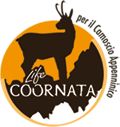The Project
The aim of the project, realized through the LIFE + financial instrument, is the conservation of the Apennines chamois Rubicapra pyrenaica ornata, a subspecies only present in the mountainous area of Apennines, central Italy. It is one of the most rare Italian species, in fact it is included as priority species in Annex II and IV of the Habitat Directive 92/43/CEE and other EU regulations, it is included in the red list defined by IUCN in 2002 as subspecies at risk of extinction, it is defined as “vulnerable” by the IUCN/SSC Caprinae Specialist Group and as “especially protected” species in the Italian legislation.
The interested areas include that defined as suitable for the species in Abruzzo Lazio and Molise National Park and Majella National Park, Gran Sasso-Laga National Park, Sibillini Mountains National Park and Sirente-Velino Regional Park.; they are continuously located along the South-North line of Central Apennines mountains, where SIC areas and 6 ZPS areas are present. The specific aim of the project – following, implementing and further developing management best practices, also made in the previous LIFE 02 NAT/IT/008538 – according to the Apennines Chamois action plan, is to assure shared conservation measures on long term:
1. To reach a consistent and viable population, increasing the number of individuals and attainment of 5 colonies in Apennine.
2. To maximize the genetic variability of ex situ conservation breeding founders.
3. To optimize management efforts in in situ and ex situ conservation through synergic and coordinated strategies by relevant administrations, as already activated by the Ministry of Environment, and that will be established and developed by the Permanent Coordination Committee for the Conservation of Apennine Chamois.
4. To maximize the contribution of ex situ conservation activities.
5. To make aware the public opinion and specific stakeholders in order to improve the acceptance in new colonies establishment and in general chamois conservation needs.
6. To understand the critical issues and promote the recovery of proper population dynamics in PNALM.
7. To retake the effectiveness of reintroduction operations in PNMS, reaching the Minimum Viable Population Value.
8. To start the 5th colony establishment, in PRSV.
9. To contain the health risks for the population.
All these objectives are National Action Plan, to the vision of IUCN/SSC Caprinae Specialist
Group and to the National annual priorities for Italy 2009 edited by Ministry of Environment.
Actions and means involved:
The principal actions of the project are:
1. Developing of coordinated actions aimed at increasing the population, the size of the distribution, genetic variability, by best practices in capturing individuals from nuclei of eligible animals in the wild and subsequent traslocation for benign introduction. (actions A.3, A.4, A.5, A.6, A.7, A.11, C.1, C.4, C.5).
2. Coordinating and decision making activities to optimize management efforts in situ and ex situ conservation through synergic and coordinated strategies by relevant administrations, by the Permanent Coordination Committee for the Conservation of Apennine Chamois. (actions A.1, A.2, D.1).
3. Ex situ conservation improving activities (actions A.10, C.3).
4. Intensive surveillance on population in PNALM, and consequent intervention programme editing, for a proper population dynamics. (actions A.5, A.12, C.2).
5. Traslocations of Chamois in key-activities for the species conservation, as the effectiveness of reintroduction operations in PNMS, reaching the Minimum Viable Population Value, and through the 5th colony establishment, in PRSV. (actions A.7, A.11, A.12, C.5).
6. Direct and indirect prophylaxis interventions on sympatric livestock, limiting the criticisms and health risks for the chamois (actions A.12, C.6).
7. Dissemination activities in order to make aware the public opinion and specific stakeholders of the acceptance in new colonies establishment and in general chamois conservation needs (actions D.2, D.3, D.4, D.5, D.6, D.7, D.8, D.10, D.11, D.12)
Expected results (outputs and quantified achievements):
1. 5 geographically isolated colonies are established, with a positive trend for the Apennine Chamois, as required by the guidelines of IUCN.
2. Capture, sample and translocation operations from wild populations are managed with the best practices in capturing and handling techiniques and with respectful methods.
3. All the relevant administations involved in the management of the Chamois territories are permanently gathered and share the best conservation strategies for the species, by means of the Permanent Coordination Committee for the Conservation of Apennine Chamois.
4. No. 4 individuals at least are traslocated in new fenced areas for captive breeding acitvities. New 4 areas are fulfilled in ex situ conservation best practices programme.
5. A new common sensitivity to Chamois protection is encouraged, for the establishment without conflicts of new colonies and for the increasing of respect in conservation needs of Apennine Chamois.
6. The Abruzzo, Lazio and Molise National Park is in condition to apply concrete management action sto population dynamics restoration.
7. The reintroduction operations in PNMS, reaching the Minimum Viable Population Value of 30 individuals, is complete and assures for long term conservation of the colony.
8. The first nucleus of Apennine Chamois is traslocated for the creation of the 5th colony.
9. All livestock breeding in Chamois core-areas for PNALM, and domestic animals in expanding areas for PNM, PNGSL, PNMS and PRSV are treated with proper vaccine and anti-parasitic drugs, at least with annual interventions.
